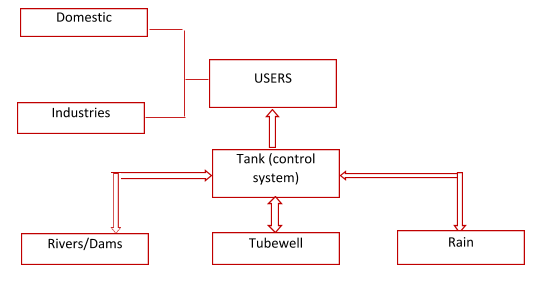
Draw a block diagram of water resources in your village.
Answer
568.5k+ views
Hint: Water is one of the basic physicochemical components of the ecosystem and is a natural resource. It is potentially a useful resource which is used by each and every living organism in different quantities. Different sources of water in the village comes under the block diagram of water resources in the village. The important sources of water are oceans, rivers, streams, groundwater and rainfall.
Complete answer:
Living organisms require water as an important element for their sustain and survival. Water is used for several processes such as household, agricultural needs, industrial purpose as well as for different environmental activities. The two types of water are marine water and freshwater. Marine water found in the oceans and seas have a high salt concentration and is unfit for drinking purposes. The freshwater sources such as ground water or rivers, streams can be utilized for drinking and other purposes.
The water resources of the villages can be described as follows:
The villagers are getting water from lakes, rivers, etc. This is the village's main water resource. Some of the villagers even dug water wells. Water with a hand pump can be obtained. Some of them wash their clothes in river water. There are even villagers bathing in the rivers. Some people even practice rainwater harvesting by storing rainwater on their houses' roofs or terraces.
The block diagram of water resources in the village is shown below:

Additional Information:
Groundwater and surface water are the main sources of drinking water in villages. Moreover, precipitation can be gathered and stored (rain and snow). The original water quality depends on the source. Water from surface (lakes, ponds, streams and rivers) is usually low in quality and requires comprehensive care for around fifty percent of the population. Groundwater is a better-quality source for about fifty percent of the population. However, liquid waste, including leachate from solid waste landfills can also be polluted or by farm runoff or the surface and subsurface disposal are known to contaminate the freshwater sources of water.
Other sources, including spring water and rain water, differ in consistency, but can be produced and handled to ensure that it is safe.
Note: In villages, water can be obtained from different sources such as dams, perennial ponds, rivers, streams, or by digging wells and others. There are a number of ways in which water management in villages can be adopted such as rainwater harvesting and others. However, the water sources are also subjected to different types of pollution and become contaminated leading to release of harmful toxins and algal blooms. This makes the water unfit for consumption or other activities.
Complete answer:
Living organisms require water as an important element for their sustain and survival. Water is used for several processes such as household, agricultural needs, industrial purpose as well as for different environmental activities. The two types of water are marine water and freshwater. Marine water found in the oceans and seas have a high salt concentration and is unfit for drinking purposes. The freshwater sources such as ground water or rivers, streams can be utilized for drinking and other purposes.
The water resources of the villages can be described as follows:
The villagers are getting water from lakes, rivers, etc. This is the village's main water resource. Some of the villagers even dug water wells. Water with a hand pump can be obtained. Some of them wash their clothes in river water. There are even villagers bathing in the rivers. Some people even practice rainwater harvesting by storing rainwater on their houses' roofs or terraces.
The block diagram of water resources in the village is shown below:

Additional Information:
Groundwater and surface water are the main sources of drinking water in villages. Moreover, precipitation can be gathered and stored (rain and snow). The original water quality depends on the source. Water from surface (lakes, ponds, streams and rivers) is usually low in quality and requires comprehensive care for around fifty percent of the population. Groundwater is a better-quality source for about fifty percent of the population. However, liquid waste, including leachate from solid waste landfills can also be polluted or by farm runoff or the surface and subsurface disposal are known to contaminate the freshwater sources of water.
Other sources, including spring water and rain water, differ in consistency, but can be produced and handled to ensure that it is safe.
Note: In villages, water can be obtained from different sources such as dams, perennial ponds, rivers, streams, or by digging wells and others. There are a number of ways in which water management in villages can be adopted such as rainwater harvesting and others. However, the water sources are also subjected to different types of pollution and become contaminated leading to release of harmful toxins and algal blooms. This makes the water unfit for consumption or other activities.
Recently Updated Pages
Give one chemical test to distinguish between aniline class 12 chemistry CBSE

Which color of white light travels fastest in glass class 12 physics CBSE

What is the chemical basis of heredity class 12 biology CBSE

State and Explain Beer Lambert Law class 12 physics CBSE

A circular loop of radius R carrying current I lies class 12 physics CBSE

Draw the structure of urotropine and write its use class 12 chemistry CBSE

Trending doubts
What are the major means of transport Explain each class 12 social science CBSE

Which are the Top 10 Largest Countries of the World?

Draw a labelled sketch of the human eye class 12 physics CBSE

Explain sex determination in humans with line diag class 12 biology CBSE

The pH of the pancreatic juice is A 64 B 86 C 120 D class 12 biology CBSE

Give 10 examples of unisexual and bisexual flowers




